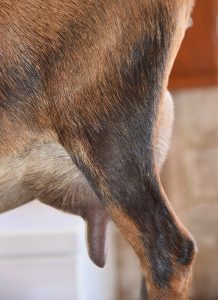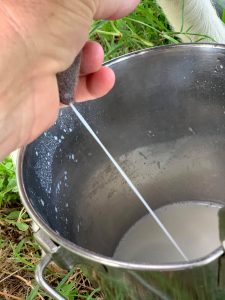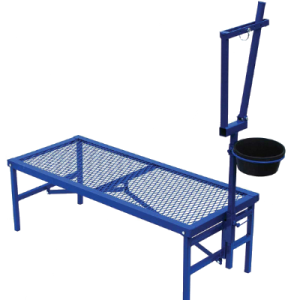Milking Nigerians
Photo credit – Old Mountain Farm, Cheryle Moore Smith & Wyl Smith
Nigerian Dwarf goats are a great choice as a milk goat for your home. They are small, easy to handle, friendly and produce enough milk per day for personal use. Not to mention the joy and amusement they will bring to you and your families life!
Why choose Nigerians for milking
Nigerians are small and with the smaller size comes the ease of handling. Getting them onto the milking stand, doing husbandry and even transporting them are all times when you will appreciate the smaller size of the Nigerian Dwarf. Families with small children and older people make the choice to own Nigerians for precisely this reason. And of course along with the smaller size comes the benefit of less feed, land area requirements and housing.
Worldwide, goat milk is the most highly consumed milk and Nigerian Dwarf goat milk is becoming increasingly popular as it contains vitamins, minerals, trace elements, electrolytes, enzymes, and proteins that are easier for humans to assimilate than milk produced from cows. You can digest goat milk in around 20 minutes against 24 hours to digest cow’s milk. People who suffer from lactose intolerance may find that goat’s milk is a good alternative since Goat milk contains less lactose than cows milk and because it passes through the digestive system so quickly those who suffer from lactose intolerance may have less difficulty with goat milk.
Also, a Nigerian’s high butterfat content makes it ideal for cheesemaking. Nigerian milk also has more of the alpha S1 protein, commonly referred to as the “cheese” protein. A high percentage of alpha S1 leads to higher yield, as well as producing cheeses with exceptionally attributes. Standard-size goats have butterfat around 3% to 3.5% with Nubians being the exception with an average of 4.5. Nigerians average 6.5%.
Milk Production

A Nigerian can produce up to 2 litres a day in sweet creamy milk, sometimes more but to get the milk flowing you need to “Freshen” the Doe, or let her have babies.
Once your Nigerian Doe has had babies you can start milking by separating the kids from their mother overnight and milking first thing in the morning before letting them back to their mother. Once the babies are weaned you are able to milk your Nigerian Doe morning and night and this is when your goat will be at peak production.
It is commonly stated that at around 5-6 months after freshening production will decrease but many Nigerians hold their milk production longer than this.
Most dairy goats can only be bred seasonally which means you will have a lot of milk after kidding but shortages in the coming months. However, Nigerians can often be breed all year around so with some good planning you can stagger you kidding to assure a constant supply of milk.
Choosing your milking Nigerian
Not all Nigerians are equal when it comes to milking. Breeders of Nigerian Dwarf Goats come in all shapes and sizes. Some produce pets, some focus on the show ring and some breed for milk production. It’s important when seeking out a goat for milking that you find a breeder that has a reputation for dairy breeding. These breeders will be able to tell you about their animals milk capacity and some will have milk tested and will be able to show you the records of what a particular goat can produce. The NDGSA has many members that are focused on milk production so take a look at our Breeders Listings here.
About Milking
 You may think that only people need to learn how to milk a goat but it’s not a natural thing for a goat to let a humans take her milk so they have some things to learn too. . If you are a novice then it may pay to get an experienced milker as your first milk goat but that’s not always possible so here are some things to help you.
You may think that only people need to learn how to milk a goat but it’s not a natural thing for a goat to let a humans take her milk so they have some things to learn too. . If you are a novice then it may pay to get an experienced milker as your first milk goat but that’s not always possible so here are some things to help you.
First, what to avoid. Fighting with when they are not doing what you need them to do will not lead to a good outcome. They are very smart and will remember the experience to your detriment. They need to associate the milk stand with happy times and good things, so that they will want to go willingly to the milking stand.
If a goat is raising her kids and misbehaves on the milk stand she is simply expressing very strong mothering instincts to keep the milk for her babies. So, if you have a new Doe then it’s time to start training!
It’s a good thing to get your Doe used to the milkstand early. A common mistake people make is to only put their goats on the milk stand when they are going to do something unpleasant like vaccinate or trim hooves or the like so it becomes a negative experience. Putting them their on other occassions to quietly eat treats is a good way to make them feel that the milkstand is a good place. Then, put them on the milk stand as early as possible after freshening, ideally within 12 hours. If you’re milking them from day one when their hormones are at a peak they will think you milking them is just as normal as their kids nursing. If their kids are the only ones getting the milk then they think that only the kids should be. If you are bottle raising kids, the does tend to be completely mellow about being milked because they don’t know any differnt.
To reinforce that the milk stand is all things goodness you should feed the Doe her daily grain ration while on the stand. You will be surprised how quickly she will get the hang of stand = food and be running to the stand as soon as you appear with her food.
So, how do you milk a goat?
It’s a simple concept. You trap the milk in the teat and then you squeeze the teat so the milk can only do one thing, come out of the orifice at the bottom of the teat. The concept is simple but learing the coordination to get good at milking a goat takes time. We are all slow and clumsy in the beginning and usually get more milk on ourselves than in the bucket!
Here is a good demonstration video by Blue Cactus Dairy on “How to milk a Nigerian Dwarf Goat”.
Things you need for milking
 A milking stand. This is a must! There are a few cooperative goats that will let you milk them anywhere but you will need a milk stand for most goats, especially if you’re a beginner. Trying to milk without a head bail to hold your doe in quietly in place will lead to frustration on both your and the Does part If you have back problems, a higher stand with a ramp is better so that you can milk comfortably standing up.
A milking stand. This is a must! There are a few cooperative goats that will let you milk them anywhere but you will need a milk stand for most goats, especially if you’re a beginner. Trying to milk without a head bail to hold your doe in quietly in place will lead to frustration on both your and the Does part If you have back problems, a higher stand with a ramp is better so that you can milk comfortably standing up.
You will of course need a bucket for the milk. It should be stainless steel and seamless for ease of cleaning and to avoid any areas that bacteria accumulate. A standard milk bucket is not suitable for Nigerians, you will need to find a smaller one from a dairy supply store. You can, of course, use a milking machine but often they don’t milk the udder completely so it’s best to still have a buck to hand milk the last bit out.
A strip cup is another necessity. It’s a stainless steel container with a filter. You milk a little milk into this, from both teats, before you start fully milking and you can see if there are any issues with the milk like a chunky appearance which is an indication of Mastitis. The first few squirts of milk are more likely to carry bacteria so using a strip cup has multiple benefits.
Very importantly you will need udder wipes. You can buy wipes specifically designed to clean udders or some say you can even use baby wipes for cleaning the udder before you start. Only use a wipe once on one teat to avoid the spreading of germs.
It’s inevitable that whilst milking you will get dust and goat hair in the milk, no matter how hard you try not to, so to resolve this you will need disposable filters to filter the milk through before putting it into a container.
Milking your Nigerian and having fresh creamy milk on hand is very rewarding and healthy and by following the information above you will have a good start to your milking experience! Happy milking!
